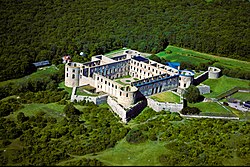|
Borgholm Municipality
Borgholm Municipality (Borgholms kommun) is a municipality in Kalmar County, south-eastern Sweden, constituting the northern half of the island of Öland in the Baltic Sea. The municipal seat is located in the city of Borgholm. Notable historic sites in this municipality are Borgholm Castle and Halltorps Estate. The local government reform in the 1970s saw the creation of two municipalities on the island of Öland. Borgholm Municipality is the northern of the two and consists of sixteen original (pre-1952) entities. The southern half of the island is made up of Mörbylånga Municipality. It is the birthplace of John Eke, A long distance runner who competed in the 1912 Olympics, He later competed for the Irish American Athletic Club in NYC LocalitiesThere are 5 urban areas (also called Tätort or localities) in Borgholm Municipality. In the table the localities are listed according to the size of the population as of December 31, 2005. The municipal seat is in bold characters.
Sister citiesBorgholm has four sister cities (a.k.a. twin towns):
DemographicsThis is a demographic table based on Borgholm Municipality's electoral districts in the 2022 Swedish general election sourced from SVT's election platform, in turn taken from SCB official statistics.[3] In total there were 10,889 inhabitants, including 8,990 Swedish citizens of voting age.[3] 45.0 % voted for the left coalition and 53.8 % for the right coalition. Indicators are in percentage points except population totals and income.
PoliticsThese are the results of the elections to the Riksdag held in Borgholm since the first election after the municipal reform that was held in 1973. The results only include parties that have won representation in the Riksdag assembly at least once during this timeframe. The results of the Sweden Democrats were not listed at a municipal level by the SCB between 1988 and 1998 due to the party's small size at the time.
Blocs This lists the relative strength of the socialist and centre-right blocs since 1973, but parties not elected to the Riksdag are inserted as "other", including the Sweden Democrats results from 1988 to 2006, but also the Christian Democrats pre-1991 and the Greens in 1982, 1985 and 1991. The sources are identical to the table above. The coalition or government mandate marked in bold formed the government after the election. New Democracy got elected in 1991 but are still listed as "other" due to the short lifespan of the party. "Elected" is the total number of percentage points from the municipality that went to parties who were elected to the Riksdag.
References
External linksWikimedia Commons has media related to Borgholm Municipality.
|
||||||||||||||||||||||||||||||||||||||||||||||||||||||||||||||||||||||||||||||||||||||||||||||||||||||||||||||||||||||||||||||||||||||||||||||||||||||||||||||||||||||||||||||||||||||||||||||||||||||||||||||||||||||||||||||||||||||||||||||||||||||||||||||||||||||||||||||||||||||||||||||||||||||||||||||||||||||||||||||||||||||||||||||||||||||||||||||||||||||||||||||||||||||||||||||||||||||||||||||||||||||||||||||||||||||||||||||||||||||||||||||||||||||||||||||||||||||||||||||||||||||||||||



